1) regenerative heating system
回热加热系统
1.
With a simulation supporting system STAR-90 serving as a platform developed is a fairly accurate mathematical model to study a regenerative heating system.
利用STAR - 90仿真支撑系统为平台 ,开发了一套较为精确的数学模型来研究回热加热系统。
2) heat regeneration
回热
1.
Vapor-liquid heat regeneration cycle performance of R22 and alternative refrigerants;
R22及其替代制冷剂的回热循环性能
3) regenerated
回热
1.
Finite-time thermodynamics is applied to analyze the performance of a real closed inter-cooled regenerated Brayton cycle coupled to variable-temperature heat reservoirs.
用有限时间热力学方法分析了变温热源条件下实际闭式中冷回热布雷顿循环的性能,导出了无因次功率及效率的解析式。
2.
The analytical formulas for the relations between power density and pressure ratio of a real regenerated Brayton cycle coupled to variable-temperature heat reservoirs are derived by using finite-time thermodynamics.
计入工质与高、低温侧换热器和回热器的热阻损失 ,压气机和涡轮机中的不可逆压缩和膨胀损失及管路系统中的压力损失 ,用有限时间热力学方法 ,导出了变温热源条件下实际回热式布雷顿循环功率密度与压比间的解析式 ;借助于数值计算 ,研究了高、低温侧换热器和回热器的热导率分配和工质与热源间的热容率匹配对最大功率密度的影响 。
4) heat recovery
回热
1.
Experimental study on mass and heat recovery of a highly efficient multi-function heat pipe type adsorption ice making system;
基于多功能热管的高效吸附式制冰机组回质回热实验研究
2.
A viable combination of recycling waste heat and heat recovery will make the adsorptive air conditioning system more competitive.
基于在回热型吸附式空调样机上开展的大量实验 ,研究了有关时间因素 (如回热时间、回质时间、半周期时间等 )对样机性能制冷系数 COP和单位质量制冷功率 SCP的影响 。
3.
In this article, detailed thermodynamic analyses of basic adsorption refrigeration cycle and regenerative adsorption refrigeration cycle is presented, an advanced adsorption cycle with internal vapour and heat recovery is developed.
本文建立了吸附式制冷基本循环和连续回热循环的热力模型,研究和发展了有蒸汽质量迁移的新型回热循环。
5) regeneration
回热
1.
Power optimization of an endo-reversible inter-cooling regeneration Brayton cycle coupled to variable-temperature heat reservoirs;
变温热源条件下内可逆闭式中冷回热布雷顿循环的功率优化
2.
Regeneration Performance of a Magnetic Ericsson Refrigeration Cycle;
磁埃里克森制冷循环的回热性能
3.
The adoption of intercooling and regeneration technology represents a major development tendency for a new generation of marine main propulsion plants.
燃气轮机采用间冷回热技术是新一代船用主动力装置的重要发展趋势。
6) heat regenerative
回热
1.
This paper is the first part for the research of heat regenerative adsorption air conditioning system (HAAS) modeling.
该文着重于回热型吸附空调系统研究的第一部分工作———建模。
2.
This paper is the second part of the research of heat regenerative adsorption air conditioning design,construction and experiment.
侧重于回热型吸附式空调系统研究的第二部分工作———工程设计、构建和实验 ,根据已建立的三热源模型设计并构建了的回热型吸附式空调系统样机 ,在样机试验台上的大量实验表明 ,三热源模型较好地预测了系统性能 ,证明了余热驱动的回热型吸附式空调系统拥有乐观的商业应用前
参考词条
补充资料:金属热处理 :感应加热热处理
用感应电流使工件局部加热的表面热处理工艺。这种热处理工艺常用於表面淬火﹐也可用於局部退火或回火﹐有时也用於整体淬火和回火。20世纪30年代初﹐美国﹑苏联先后开始应用感应加热方法对零件进行表面淬火。随著工业的发展﹐感应加热热处理技术不断改进﹐应用范围也不断扩大。
基本原理 将工件放入感应器(线圈)内(图1 感应加热原理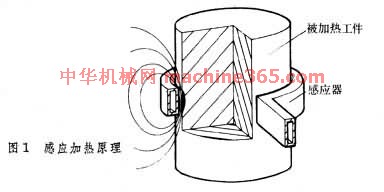 )﹐当感应器中通入一定频率的交变电流时﹐周围即產生交变磁场。交变磁场的电磁感应作用使工件内產生封闭的感应电流──涡流。感应电流在工件截面上的分布很不均匀﹐工件表层电流密度很高﹐向内逐渐减小(图2 沿工件截面的电流密度分布
)﹐当感应器中通入一定频率的交变电流时﹐周围即產生交变磁场。交变磁场的电磁感应作用使工件内產生封闭的感应电流──涡流。感应电流在工件截面上的分布很不均匀﹐工件表层电流密度很高﹐向内逐渐减小(图2 沿工件截面的电流密度分布 )﹐这种现象称为集肤效应。工件表层高密度电流的电能转变为热能﹐使表层的温度昇高﹐即实现表面加热。电流频率越高﹐工件表层与内部的电流密度差则越大﹐加热层越薄。在加热层温度超过钢的临界点温度后迅速冷却﹐即可实现表面淬火。
)﹐这种现象称为集肤效应。工件表层高密度电流的电能转变为热能﹐使表层的温度昇高﹐即实现表面加热。电流频率越高﹐工件表层与内部的电流密度差则越大﹐加热层越薄。在加热层温度超过钢的临界点温度后迅速冷却﹐即可实现表面淬火。
分类 根据交变电流的频率高低﹐可将感应加热热处理分为超高频﹑高频﹑超音频﹑中频﹑工频 5类。①超高频感应加热热处理所用的电流频率高达27兆赫﹐加热层极薄﹐仅约0.15毫米﹐可用於圆盘锯等形状复杂工件的薄层表面淬火。②高频感应加热热处理所用的电流频率通常为200~300千赫﹐加热层深度为0.5~2毫米﹐可用於齿轮﹑汽缸套﹑凸轮﹑轴等零件的表面淬火。③超音频感应加热热处理所用的电流频率一般为20~30千赫﹐用超音频感应电流对小模数齿轮加热﹐加热层大致沿齿廓分布﹐粹火后使用性能较好。④中频感应加热热处理所用的电流频率一般为2.5~10千赫﹐加热层深度为2~8毫米﹐多用於大模数齿轮﹑直径较大的轴类和冷轧辊等工件的表面淬火。⑤工频感应加热热处理所用的电流频率为50~60赫﹐加热层深度为10~15毫米﹐可用於大型工件的表面淬火。(见彩图 差温炉淬火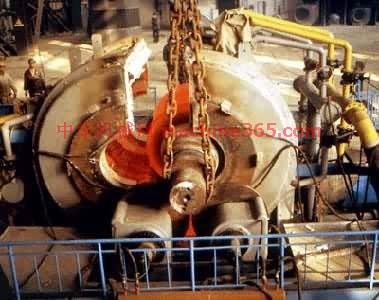 ﹑ 600毫米直径冷轧辊工频感应加热淬火
﹑ 600毫米直径冷轧辊工频感应加热淬火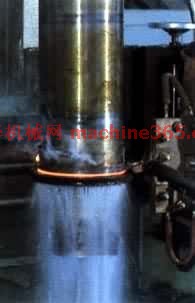 ﹑ 大型铸钢件的热处理炉
﹑ 大型铸钢件的热处理炉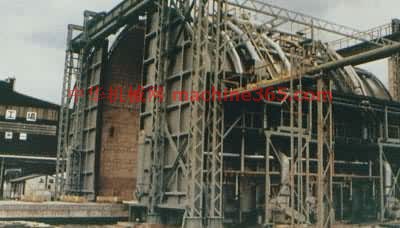 ﹑ 真空淬火炉
﹑ 真空淬火炉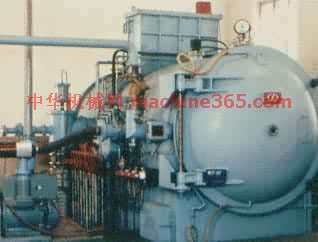 )
)
基本原理 将工件放入感应器(线圈)内(图1 感应加热原理
 )﹐当感应器中通入一定频率的交变电流时﹐周围即產生交变磁场。交变磁场的电磁感应作用使工件内產生封闭的感应电流──涡流。感应电流在工件截面上的分布很不均匀﹐工件表层电流密度很高﹐向内逐渐减小(图2 沿工件截面的电流密度分布
)﹐当感应器中通入一定频率的交变电流时﹐周围即產生交变磁场。交变磁场的电磁感应作用使工件内產生封闭的感应电流──涡流。感应电流在工件截面上的分布很不均匀﹐工件表层电流密度很高﹐向内逐渐减小(图2 沿工件截面的电流密度分布 )﹐这种现象称为集肤效应。工件表层高密度电流的电能转变为热能﹐使表层的温度昇高﹐即实现表面加热。电流频率越高﹐工件表层与内部的电流密度差则越大﹐加热层越薄。在加热层温度超过钢的临界点温度后迅速冷却﹐即可实现表面淬火。
)﹐这种现象称为集肤效应。工件表层高密度电流的电能转变为热能﹐使表层的温度昇高﹐即实现表面加热。电流频率越高﹐工件表层与内部的电流密度差则越大﹐加热层越薄。在加热层温度超过钢的临界点温度后迅速冷却﹐即可实现表面淬火。 分类 根据交变电流的频率高低﹐可将感应加热热处理分为超高频﹑高频﹑超音频﹑中频﹑工频 5类。①超高频感应加热热处理所用的电流频率高达27兆赫﹐加热层极薄﹐仅约0.15毫米﹐可用於圆盘锯等形状复杂工件的薄层表面淬火。②高频感应加热热处理所用的电流频率通常为200~300千赫﹐加热层深度为0.5~2毫米﹐可用於齿轮﹑汽缸套﹑凸轮﹑轴等零件的表面淬火。③超音频感应加热热处理所用的电流频率一般为20~30千赫﹐用超音频感应电流对小模数齿轮加热﹐加热层大致沿齿廓分布﹐粹火后使用性能较好。④中频感应加热热处理所用的电流频率一般为2.5~10千赫﹐加热层深度为2~8毫米﹐多用於大模数齿轮﹑直径较大的轴类和冷轧辊等工件的表面淬火。⑤工频感应加热热处理所用的电流频率为50~60赫﹐加热层深度为10~15毫米﹐可用於大型工件的表面淬火。(见彩图 差温炉淬火
 ﹑ 600毫米直径冷轧辊工频感应加热淬火
﹑ 600毫米直径冷轧辊工频感应加热淬火 ﹑ 大型铸钢件的热处理炉
﹑ 大型铸钢件的热处理炉 ﹑ 真空淬火炉
﹑ 真空淬火炉 )
) 说明:补充资料仅用于学习参考,请勿用于其它任何用途。